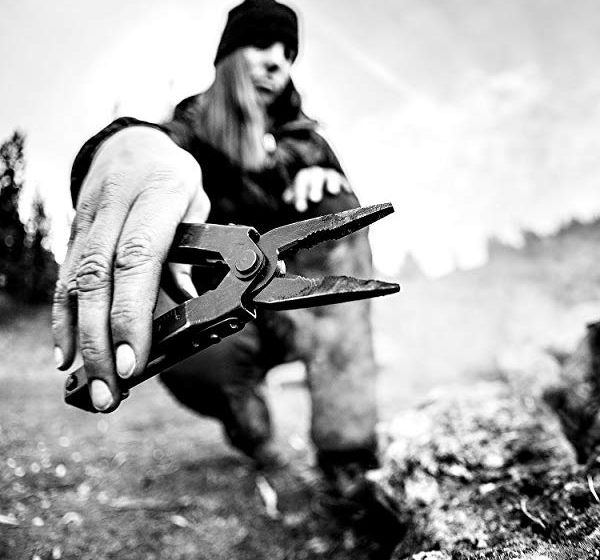
I still remember like it was yesterday.I was crazy about the show Survivorman as a kid. And there was this one episode where Les Stroud heads into the woods for 7 days to film himself surviving and teaching survival skills to the audience. It also happens to be the show that caused me to become an outdoor guide and, eventually, an outdoor writer.
In the show Survivorman, Les is famous for carrying several items to aid his survival. One of them, which he almost always carries, is a multitool. Although his personal choice of multitool tends to change regularly. That led me to purchase my first ever multitool as a young outdoor enthusiast. You’ll be sad to know that I’ve long since lost that multitool but it lives on fondly in my memories.Regardless if you’re buying a backpacking multitool to be cool, like I did, or if you have a need for one that exceeds mine I’m going to help you make a good buying decision.Over the years I’ve seen good, bad, and ugly multitools and my goal is to help you spend your cash wisely.
Comparison Chart
|
Name |
Price |
Weight |
Rating |
Notes |
|---|---|---|---|---|
|
$$$ |
2.2 oz |
10 tools: Needle nose spring-loaded pliers, Wire cutter, Fine edge blade, Retail package opener, Scissors, Medium flat driver, Crosshead driver, Bottle opener, Tweezers, File |
||
|
$$$ |
1.9 oz |
Equipped with 9 tools, including a knife, pliers, screwdrivers, wire cutters, scissors, a bottle opener, and a file. |
||
|
$$$ |
8.6 oz |
Lifetime Warranty |
||
|
$$$ |
6.88 oz |
The Wingman only requires one hand to open and use all the tools, even the ones that aren’t accessible from the outside. And with a locking blade, you can cut with confidence. |
||
|
$$$ |
9.6 oz |
Convenient, easily accessible butterfly opening |
What Makes a Backpacking Good Multitool?
Sport-Specific Multitools
I noticed the other day at a sporting goods store that today’s multitools from makers like Gerber and Leatherman come in many flavors. Even more than they used to!You can find multitools made with gadgets specifically for things like:
- Fishing
- Hunting
- Everyday carry
- Technology
- Lightweight
Each of these will vary slightly from others by the tools it uses or it may have a different size, style, or type of jaw. Fishermen, for instance, may want pliers that are good at retrieving hooks while a hunter might want more sturdy jaws for tightening arrow broadheads or clipping bones.For backpackers, a minimalist or lightweight multitool is probably the best bet. Larger multitools can be very heavy unless you’re also hunting or fishing on your backpacking trip, stick with a lightweight tool.
Weight
I’ve already alluded to this a bit and if you’ve read any of our other guides then you already know that weight matters. Every ounce in your backpack must count or it should stay home!When comparing multitools consider that a Victorinox Classic pocket knife (knife, flat head, file, scissors, tweezers, toothpick) weighs just about 0.75 ounces. Any extra weight on a multitool for backpacking, in my view, should be justified by significant improvements in tool functionality over this ultralight benchmark.With only a few exceptions I’ve rarely found myself wishing I had more tools or pliers while backpacking. However, there are those times when a pair of pliers or multitool could come in handy and that extra weight will be worth carrying.
Construction
Cheap multitools you might find on clearance at Walmart or super cheap online are probably going to fail you early on. I’m just going to go ahead and say it.Plastic handles or scales are common on cheap multitools. Plastic is guaranteed to eventually break or bend on a multitool and even for handle scales, I say avoid it entirely.Aluminum is strong and light. It makes a great choice for multitool frames because it can be easily machined and refined to create good-looking, lightweight frames.Steel comes in many varieties but stainless steel is the most common for multitools. Steel should be used in all the implements of your multitool though I wouldn’t recommend overthinking it – even cheap stainless steel will be just fine for most uses though fancy blade steels are easy to find from lofty manufacturers.Screws tend to be fancy and unnecessary adding more fashion than function to many multitools. Is your multitool held together with Torx screws? Make sure you buy a set of Torx screwdrivers to service it if you ever want to take it apart.Rivets in multitools should be made of steel. Aluminum rivets are soft and can shear off after stressful use. Good, thick, steel rivets will hold up fantastically over time.
Jaw Style
Backpackers may have different preferences when it comes multitool jaw style. Every multitool revolves around the pliers in the center and making sure you get the right kind is pivotal (pun intended) to getting the most out of your tool.Flat Jaw tools have short, stubby jaws. These powerful jaws are great for high grip strength when working with stubborn nuts, bolts, or bending metal. They’re beefy and hard to get into small spaces, however.Needle Nose tools are thin, slender jaws which excel at slipping into tight areas. These are great for fishermen, electricians, or repairing and working on small items in the field.Specialized multitools may replace the standard jaws with large scissors, clippers, or other equipment that is not a traditional plier.
How Many Tools are Too Many?
At some point, you’ll run into those multitools that make their name by having every tool known to man. Of course, these can be hampered by the fact that they’re large, heavy, and often the tools are marginally helpful at best.When deciding between two multitools that are otherwise similar, think about what tools you’re really likely to use. Useful tools might be screwdrivers, one knife, a file, scissors and other daily users.Tools you probably don’t need are extra knives (how many will you really use) or corkscrews. I mean, are you really going to be opening wine bottles on a backpacking trip on a regular basis? I suspect not.In general, approach tool selection with a critical eye and consider what’s really worth your time.
A Note About Manufacturers
Two major manufacturers play in the multitool market. Now, let me preface this by saying that there are tons of other makers of multitools but I want to give you a quick introduction to two of the bigger ones.Gerber makes great quality knives and multitools and they’ve been one of my favorites for years. They’re like Columbia in that they offer great quality-value ratios on their gear. You’ll be hard pressed to find better prices for the quality on any multitools other than Gerber.Leatherman is the Cadillac of multitools. Their tools are robust, durable, and often loaded with tools. Somehow they’ve gained the reputation as the top dog in multitool circles and you’ll usually see them touted as the best multitool makers around.
Sheaths
Multitools often come with nylon sheaths that help hold your tool at the ready. There are to main considerations here:Belt sheaths are great for full-size multitools which you’ll use in the front country. On backpacking trips, however, you can’t really carry them on your belt since the backpack hip pads go there.Instead, you can use the belt sheaths to attach to your shoulder straps with a carabiner or clip of some kind.General sheaths are my fancy term for a multitool holster. If it doesn’t have a belt loop on it, it might just be good for keeping track of your multitool and protecting it. If you toss a metal multitool into your pack without a sheath, it may scratch other items so a sheath makes some sense for packability so it’s not banging against your electronics or other sensitive gear and doing damage.No sheath is a good call for pocket-sized multitools. There’s no need for a sheath if you just keep it stored loosely in your pocket with your keys most of the time. A sheath would probably just be an extra step between you and using the tool anyways.
Tool Locks
Many, if not all multitools have some kind of tool locks. Once you open the tool up and deploy the knife, bottle opener, or scissors they automatically should lock into place.This feature prevents knife blades or screwdrivers from collapsing on your fingers with catastrophic results.Some cheaper multitools lack a full hard lock and instead use a pressure lock. Pressure locks just help hold the tools in place and don’t necessarily ensure that they’re fully locked in place. Be careful with this style!
Best Backpacking Multitools of 2018
Gerber Dime Multi-Tool, Black [30-000469]
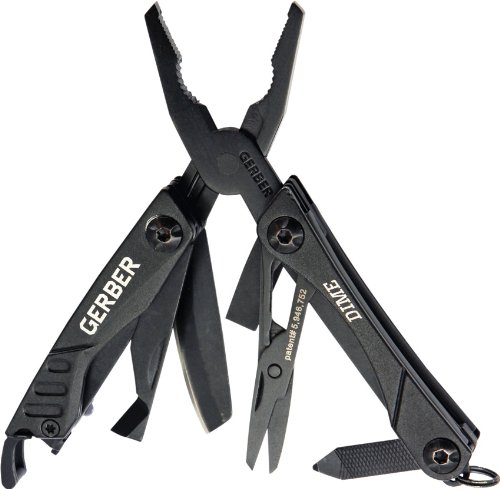
To find the best backpacking multitool for our list I set out with some criteria in mind. I was looking for something lightweight. It had to have more tools than the standard Victorinox Classic I carry, and it had to have a good, reliable set of pliers.
Readers, meet the Gerber Dime Multi-Tool – it’s the best multitool for backpacking and probably the best for your money on our list, by far.
- Flat jaw style
- 2 ounces
- Minimal tools
Scissors, file, screwdrivers, knife, pliers and few other tools adorn this folding set of flat jaw pliers. They’re small enough to for EDC pocket carrying without getting in the way which is ideal. In my opinion, the best multitools can be carried all the time without hassle so they’re there when you need them.
Leatherman – Squirt PS4 Multitool, Black
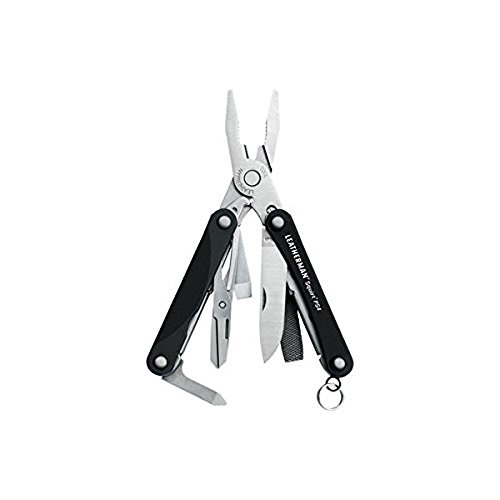
Not happy with the Gerber Dime? How about we flip to the other side and take a look at the premium Leatherman Squirt which is essentially a juiced up version of the Dime.Both the Dime and the Squirt are right around that 2-ounce mark which makes them ideal candidates for the out of sight, out of mind carrying that makes a multitool the handiest. Plus, I think there’s something to be said about keeping things simple.I will say that it’s a much more expensive multitool for almost the same features. At nearly twice the price you get practically the same multitool.
- Flat jaw style
- 2 ounces
- Refined design
The one thing I like about the Leatherman Squirt over the Gerber Dime is that the file and screwdrivers are a little beefier looking. They’re more individual and dedicated which makes me feel like they’ll hold up better over the long run.
Gerber Bear Grylls Ultimate Multi-Tool [31-000749]
Bear Grylls might be considered the wild cousin of Les Stroud. His crazy antics and action-packed survival shows have earned him many signature lines and Gerber’s Bear Grylls products are one of those.There are a couple upgrades here that might be worth noting to many of you:Serrated knives, like one of the two on this tools, help protect the blade and keep it sharp. That means you’ll always have a blade that’s got plenty of sharpness to saw through rope or bone.Another critical survival style tool that can often be worth its weight in gold is the fold out saw like the one in this tool. They’re sharp, crazy effective, and very easy to use. On the downside, however, this one is pretty short so you’ll be doing a lot of sawing before you get through anything major.
- Needle nose style
- 8+ ounces
- Larger and more specialized tools
I will say that in this case, I don’t mind seeing two different knife blades on a multitool. I personally hate using serrated blades for most tasks so it’s nice to see a non-serrated fine edge blade also included in the tool for most knife work.
Leatherman – Wingman Multitool, Stainless Steel (831426)
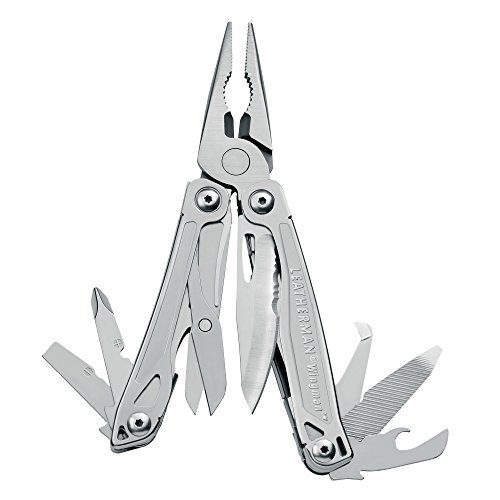
I think it’s only right that after all this we talk about the flagship multitools from both of the best makers in the industry. For that, we’re going to start by looking at the Leatherman Wingman series.At just 7 ounces it’s not a brick but it’s almost 3 times as heavy as the smaller backpacking multitools we looked at earlier. Plus, you’re also going to pay more than 3 times what you’d pay for a minimalist version like the Gerber Dime.That said, it may have features important to you like a hooked package opener or wire strippers. Before you start scoffing at the “package opener” (which is essentially a backward facing hooked blade) think about how it might be used in the outdoors. This mini, hooked blade could be great for skinning or gutting fish or game in the field so it’s worth thinking about.While the knife, file, bottle opener, and scissors are larger on this model than the more compact models, the standalone Philips and flat head drivers seem a little unnecessary for most backpacking trips. There is, however, a single knife that is half serrated and half plain edge so if that’s your preference this might be the tool for you.
- Needle nose style
- 7 ounces
- Full-size multitool without too many extras
Gerber Suspension Multi-Plier [22-01471]
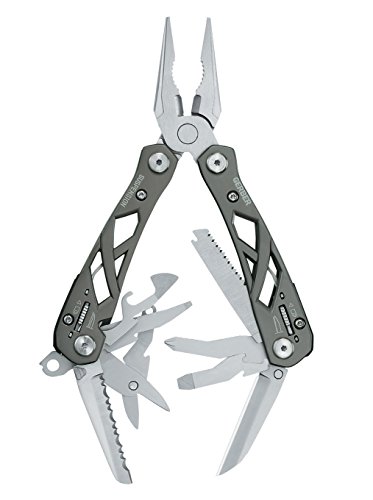
Probably my favorite of all the full-size multitools is the Gerber Suspension. The price is absurdly affordable and the tools are on-point.
Gerber has been doing the paraframe-style handles for a long time and the hollow design is both lighter and sexier looking than a solid slab handle.One feature I really like is that all the tools lock into place with a little lever that has to be pressed to release them. That way they don’t collapse on you when you’re trying to twist, pry, or cut. Of course, this is a pretty common feature but the location and design of the locks on this tool specifically looks and functions well in my opinion.
- Needle nose style
- 9.6 ounces
- Great tools for backpackers
I will say that I’m not the biggest fan of separate serrated and fine edge knives, but you know that. I think they make up for it with intelligent use of the saw design, bottle opener, and can opener.
Conclusion
Today, more than in the past, it seems like every tool or piece of gear can be found from cheap manufacturers based in unknown locations. Many of these cheap pieces of gear turn out to be great, some of them turn out to be junk.Me? I prefer not to gamble when it comes to my backpacking gear. If I’m going to rely on a tool to potentially save my life in the wilderness then it’s going to be a good quality tool for sure!That’s why I made a point to restrict our list of the best backpacking multitools to proven manufacturers that I personally trust and feel comfortable recommending to others.When you head into the woods with a multitool, I always make sure to carry a backup knife at least. It’s just too easy to drop, set down and forget, or just lose your multitool when it matters most. If that happens to be the case I’d rather have something for backup, I don’t know about you!From here what you should do is use our list to narrow down the multitools with the gadgets you’re likely to use. Once you find one or two that seem just right, go over the weight and tool types included in the multitool you’re considering and ask yourself how likely and how often you’ll use each tool. If you think you’re unlikely to use more than half the tools on a regular basis, look for a different tool.Once you follow this process you’ll be left with the perfect backpacking multitool for you!

